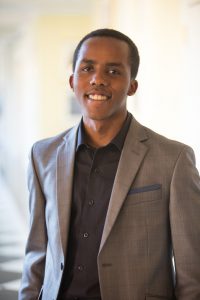
May 27, 2020
Mathew Atisa’s desire to study computer science began with an interest in computers in middle school, it was further fostered by his courses and extracurricular activities in high school. As a first-year student at UNC he’s enjoying the computer science curriculum, but he’s also excited by the opportunity to challenge himself through participation in undergraduate research and as a young entrepreneur.
In February, Atisa earned first-prize in the Duke Research Computing Symposium Poster Session, for his poster titled, “Deep Learning with Specialized Training for Fast Computer Generated Holography”. As a dedicated student and researcher, Atisa shared with us the ways computer science students can apply their knowledge and skills, making an impact across disciplines.
As a first-year student, how did you find out about undergraduate research?
I was talking with a friend who was involved with research in a lab on campus, I have always enjoyed solving problems, seeking information, and learning; getting involved with undergraduate research seemed like something I would enjoy. I decided to find out more information about open research positions. I found the database on the Office of Undergraduate Research website, where I saw a posting for an open position in the Computational Biophotonics Laboratory. I emailed Nicolas C. Pégard, Assistant Professor and leader of the lab, soon afterward I started my research position.
The research in the Computational Biophotonics Laboratory is interdisciplinary, an intersection of optics, biology, and computer science – did you have experience in other areas outside computer science before beginning?
Often, as it relates to my experience in research, I think back to a quote posted at my high school by Marissa Mayer, it said, “I always did something I was a little not ready to do. I think that’s how you grow.” Doing graduate level math and learning to build models using advanced AI is challenging, it has required dedicating a lot of time outside of my classes to build a solid foundation of these concepts. I am glad I’ve done it, there’s so much you can do with sheer willpower and determination. My research group’s project uses AI to make better, faster, and more accurate holographic images; I’m using computer science to solve an applied problem. Deep learning algorithms like ours are perfectly suited to solve multidimensional nonlinear problems like the ones you find in computer generated holography, and with offline training, can eliminate trade-offs between speed and quality. Our method outperforms all others in speed while preserving accuracy.
Outside of research, what other ways are you involved at Carolina?
I also have a few start-up ideas, I have participated in the Carolina Challenge Pitch Party and the Makeathon – programs that provide workshops and mentorship to student entrepreneurs. My friends and I gained valuable experience at these events. One of our ideas is to explore how using AI and leveraging open source code, we can generate game assets that can reduce barriers of entry to video game development by brining down costs. I am also involved with student clubs on campus, OASIS (Organization for African Students’ Interests and Solidarity) and Refugee Health Initiative.
